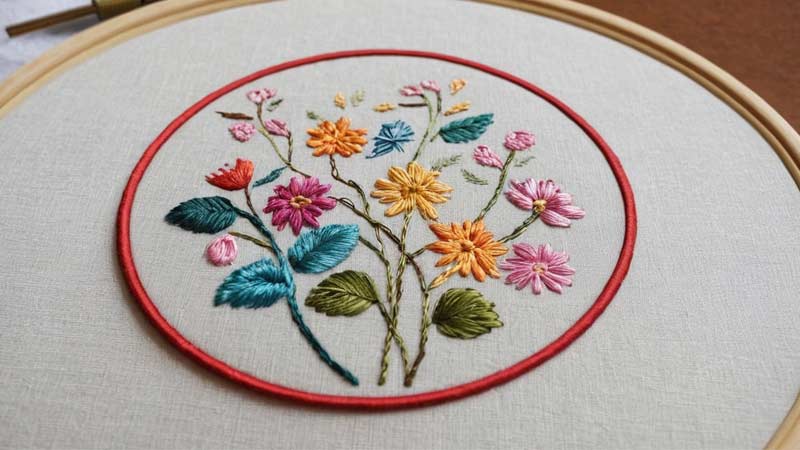Embarking on the intricate journey of needlecraft, many enthusiasts find themselves entangled in the terminology of various techniques.
Among these, needlepoint and cross stitch often cause confusion, their similarities and differences weaving a delicate tapestry of inquiry.
While both crafts involve stitching with a needle and thread, a nuanced exploration reveals unique characteristics that set them apart.
Needlepoint, often likened to painting with threads, encompasses many stitches on canvas, creating intricate designs and textured masterpieces.
On the other hand, the cross stitch, with its structured grid-like pattern, forms detailed images with X-shaped stitches on the fabric. So, is needlepoint the same as cross stitch?
As we delve into the world of needlecraft, let’s unravel the subtleties that distinguish needlepoint from cross stitch, appreciating the artistry each technique brings to the fingertips of those who thread the needle in pursuit of creative expression.

Is Needlepoint the Same as Cross Stitch?
Below is a comprehensive guide exploring the question, “What is the difference between needlepoint and cross stitch?“. Let’s look at these techniques that reveal distinct characteristics that set them apart.
Introduction to Needlepoint
Needlepoint, also known as canvaswork, involves creating intricate designs on a canvas using various stitches. The canvas is a foundation for embroidery, allowing enthusiasts to experiment with different textures and patterns.
This form of needlecraft is often likened to painting with threads, emphasizing creativity and artistic expression.
Varieties of Needlepoint
In needlepoint, various stitches, including tent, basketweave, and continental, form elaborate patterns. The process requires precision, as each stitch contributes to the overall texture and appearance of the final piece.
The range of stitches and the freedom to blend colours make needlepoint a versatile and visually rich art form.
Introduction to Cross Stitch
Conversely, the cross stitch is characterized by its structured grid-like pattern. This technique involves creating X-shaped stitches on fabric, following a predetermined pattern or chart.
Unlike the freeform nature of needlepoint, cross stitch adheres to a more organized approach, making it accessible for beginners while offering complexity for advanced stitchers.
Varieties of Cross Stitch
The foundation fabric for cross-stitching is typically Aida cloth, which features evenly spaced holes for easy counting and stitching. The stitches in cross stitch create a pixelated effect, forming detailed images with a charming handmade aesthetic.
This precision and uniformity contribute to the popularity of cross stitches for creating portraits, samplers, and decorative items.
Key Difference Between Cross Stitch and Needlepoint: Material, Stitches, and Patterns

A key distinction lies between needlepoint and cross stitch, evident in the choice of materials, stitches, and patterns employed in each technique.
Foundation Material
Needlepoint works best with Canvas. The canvas serves as a versatile foundation, available in various mesh sizes. This flexibility allows for creating different textures and intricate designs, fostering a canvas for artistic expression.
Cross Stitching requires Aida cloth. Aida cloth forms the foundation for precise stitching with its regularly spaced holes.
The structure of Aida cloth results in a grid-like appearance, offering a disciplined canvas for pixelated patterns.
Stitches
Diving into diverse stitches, such as tent and basketweave, needlepoint enthusiasts revel in creative freedom. These stitches contribute to the embroidered piece’s texture and overall appearance, showcasing the intricacies of this craft.
The hallmark of cross stitch lies in its reliance on the X-shaped stitch. This uniform stitch creates a pixelated effect, contributing to the precision and structured appearance of the final design.
Patterns and Charts
Designs in needlepoint may take form directly on the canvas through painting or be provided as charts. This allows for interpretation and flexibility, encouraging artisans to infuse their unique creative touch into the piece.
Operating with a meticulous approach, cross stitch follows predetermined patterns or charts. Each square on the chart corresponds to a specific stitch, ensuring the accurate replication of the intended image with disciplined precision.
Choosing Between Needlepoint and Cross Stitch
The decision between needlepoint and crossstitch ultimately depends on personal preference, artistic inclination, and the desired level of precision.
Needlepoint suits those seeking artistic freedom and a broader range of stitches, while cross stitch appeals to individuals who enjoy following precise patterns with a structured approach.
Cross Stitch Vs Embroidery: What Are the Differences?

Let’s unravel the threads and explore the key differences between cross stitch and embroidery, shedding light on their individual features and creative potential.
Introduction to Cross Stitch
Cross stitch, renowned for its structured and grid-like patterns, involves creating X-shaped stitches on fabric. This technique is characterized by its pixelated appearance, where each stitch contributes to forming a detailed image or design.
The foundation fabric commonly used for cross-stitching is Aida cloth, which features evenly spaced holes that facilitate precise counting and stitching.
Types of Patterns in Cross Stitch
One of the defining aspects of cross stitch is its reliance on charts and patterns. Stitchers follow a predetermined design, with each square on the chart corresponding to a stitch on the fabric.
This systematic approach makes cross stitch accessible to beginners and seasoned stitchers, offering a satisfying blend of simplicity and complexity.
Introduction to Embroidery
Embroidery, on the other hand, is a broader term encompassing a variety of stitches and techniques used to embellish fabric.
Unlike the grid-like structure of cross stitch, embroidery allows for more artistic freedom, enabling stitchers to create intricate designs, monograms, and embellishments using diverse stitches.
Types of Stitches in Embroidery

Embroidery stitches include satin, chain, French knots, and more. These stitches offer texture, dimension, and a painterly quality to the fabric.
Embroiderers often work with various threads, from traditional floss to speciality threads like silk or metallic threads, enhancing the visual appeal of their creations.
Key Differences Between Embroidery and Cross Stitch
Each stitch, pattern, and choice of fabric contribute to crafting narratives that unfold uniquely in these two diverse techniques.
Stitch Structure
Cross Stitch is a canvas of precision that unfolds as X-shaped stitches align in a structured grid, resulting in a pixelated image. The disciplined arrangement of stitches creates a visual tapestry characterized by order and accuracy.
In embroidery, the canvas becomes a playground for artistic expression. Embroidery, with its vast array of stitches, transcends the constraints of a structured grid.
The varied stitches offer a tapestry of texture, enabling stitchers to create beyond the limitations of a precise arrangement.
Foundation Fabric
In cross stitch, the choice of Aida cloth is deliberate, featuring evenly spaced holes that precisely guide the needle. This foundation reinforces the structured nature of cross stitch, ensuring that each stitch falls into place with meticulous accuracy.
Embracing versatility, embroidery ventures beyond a singular fabric choice. Various fabrics become a canvas for creativity, allowing for a rich interplay of textures and appearances. The freedom to select different fabrics contributes to the individuality of each embroidered piece.
Approach and Patterns
A journey of replication unfolds in cross stitch, where predetermined charts and patterns guide the needle with precision. This methodical approach emphasizes the importance of replicating designs accurately, creating a pixelated image true to the intended pattern.
Artistic freedom takes center stage in embroidery. Stitchers are not confined to predetermined charts; instead, they embark on a journey of creative interpretation. Diverse stitches provide a means for original designs to flourish, enabling each embroidered piece to tell a unique story.
Choosing Between Cross Stitch and Embroidery
The decision between cross stitch and embroidery often hinges on personal preference, artistic inclination, and the desired level of creativity.
Cross stitch appeals to those who appreciate the satisfaction of following precise patterns, creating pixelated images with a structured approach.
On the other hand, embroidery attracts artisans seeking artistic freedom, a broader range of stitches, and the ability to infuse personal flair.
FAQs
What Materials Are Used in Needlepoint?
Needlepoint typically utilizes canvas as the foundation material in various mesh sizes. The stitches are worked with wool or embroidery threads. The choice of canvas and threads provides flexibility for different textures and designs.
Is Needlepoint Hard for Beginners?
Needlepoint can be both enjoyable and accessible for beginners. Starting with simple stitches and gradually progressing to more intricate ones helps build skills. The key is to begin with smaller projects to grasp the basics of needlepoint.
How Does Needlepoint Differ from Embroidery?
Needlepoint typically utilizes a variety of stitches on canvas, creating textured designs. Embroidery encompasses a broader range of stitches and techniques.
Is Needlepoint Hard to Learn for Someone New to Crafting?
Learning needlepoint can be an enjoyable process for someone new to crafting. Starting with basic stitches and gradually advancing to more complex techniques allows beginners to develop skills at their own pace.
Is Needlepoint Suitable for Small Projects?
Absolutely! Needlepoint is well-suited for small projects, making it a versatile craft for various applications. Small needlepoint projects like ornaments, coasters, or bookmarks allow crafters to explore different stitches and techniques.
Conclusion
While needlepoint and cross stitch share the common ground of needle and thread, their distinct techniques give rise to unique artistic expressions.
Needlepoint’s canvas becomes a canvas for a painterly approach, allowing for a broad spectrum of stitches and textures, while cross stitch adheres to a more structured grid, forming precise images with each carefully placed X-shaped stitch.
Whether you find solace in the rhythmic repetition of cross stitches or prefer the freeform creativity of needlepoint, both crafts offer a canvas for personal expression and artistic exploration.
As we untangle the threads of confusion surrounding these two needlework styles, let your passion, patience guide the choice between needlepoint and cross stitch, and the artistry you wish to bring to life with every needle and thread.
May your future stitches be a testament to the rich tapestry of creativity that unfolds beneath your nimble fingers.
Leave a Reply